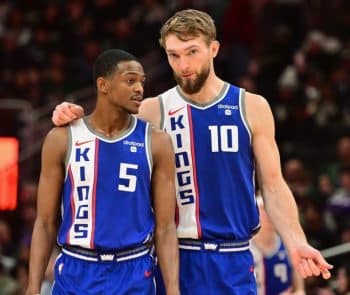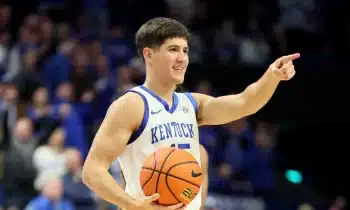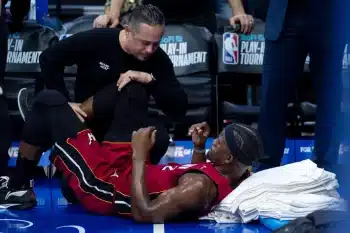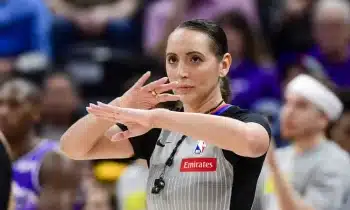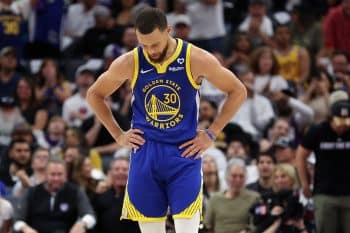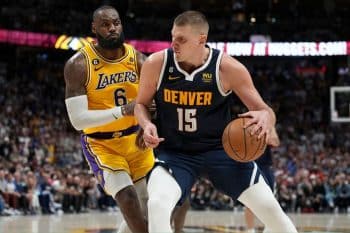NBA
Is Draymond Green Worth a Max Contract?

Over the last two seasons, Draymond Green has established himself as one of the best values in the NBA. Selected with the 35th pick in the 2012 NBA Draft, Green is currently a key piece for the Golden State Warriors, a team that is considered one of the favorites to win the championship this season.
However, Green is set to be a restricted free agent this upcoming offseason and he raised some eyebrows recently when he talked about the likelihood of this current Warriors team staying together past this season.
“This team right here, this team will probably never be together again,” Green said on Sunday after the Warriors’ win over the Celtics. “That’s just the nature of the business. One addition, one subtraction, this isn’t together no more. So take advantage while you got it. Because I’m sure this team will never be together again.”
Green reacted strongly to people suggesting that this quote meant he was likely to leave the Warriors in free agency. However, considering how well he has played recently, how valuable he is to the Warriors, and Golden State’s financial situation (they will probably need to move David Lee to keep Green), it’s a valid subject to ponder. Where Green ultimately ends up will have a lot to do with how other teams value him and what they are willing to offer him as a free agent. But Green is a unique forward that does a ton of things that aren’t represented in a traditional box score. So the question many are wondering is, what is Green worth in free agency?
Let’s take a look at Green’s body of work and how he compares to some of the best, and highest-paid small forwards in the league.
Green is a very unique player. Standing 6’7 and weighing in at 230 pounds, Green is a stocky small forward that can also play power forward effectively, and guard every position except center. This season, he is averaging 11.1 points, 8.2 rebounds, 3.6 assists, 1.6 steals and 1.4 blocks per game while shooting 43.1 percent from the field and 33.8 percent from beyond-the-arc. Green’s numbers are up across the board this season, and he has turned himself into a legitimate threat from the perimeter (Green shot just 20.9 percent from three-point range in his rookie season).
However, Green’s per game stats to a certain extent fall below the numbers expected from someone who could potentially receive a max contract. Here is a chart of the per 36 minute statistics from some of the highest-paid small forwards in the league (note that Paul George’s stats are from last season).
Courtesy of basketball-reference.com
The biggest deficiency for Green here is scoring. The second-lowest scoring forward in this group is Rudy Gay, who averages 20.5 points per 36 minutes. Green is 8.1 points behind Gay, and 14.6 points behind Durant (who leads the group in scoring per 36 minutes). However, other than scoring, three-point percentage, free throw rate and free throw percentage, Green compares fairly well against the best small forwards in the league.
More important than per game statistics, Green simply helps the Warriors win games. Consider that the Warriors are scoring 109.5 points per 100 possessions (second) and holding teams to 98.0 points per 100 possessions (first), good for a league best 11.6 net rating, per NBA.com. Those are great numbers that show just how good the Warriors have been this season. But when Green is on the floor, the Warriors are scoring 111.6 points and holding opponents to just 95.6 points per 100 possessions, good for a 16.0 net rating. The only Warrior that has a better net rating when he is on the court is Stephen Curry (16.7), who is arguably one of the five best players in the league and is currently in a three-way race for this season’s MVP award with James Harden and Russell Westbrook.
In addition, Green scores well in several advanced metrics that are designed to show how effective a player is on the court. Green is ranked 12th overall in ESPN’s Real Plus-Minus statistic and third among small forwards behind only LeBron James and Kawhi Leonard (5.08), ninth in wins above replacement (8.86), and first in defensive win shares (3.9).
One measure that Green doesn’t score particularly well in, however, is Player Efficiency Rating (PER).
Courtesy of basketball-reference.com
As we can see from this chart, Green’s PER rating is well below the other top small forwards in the league, and is just around league average. However, PER is designed to reward players that have a higher usage percentage and take a higher volume of shots. With a 16.3 usage percentage, and just 10.5 field goal attempts per 36 minutes, it is not surprising that Green ranks out as average in PER.
But this brings up another key consideration for any team that is interested in signing Green this offseason. The question of whether a very effective role player can become a team’s primary star player with a larger role is interesting. The last best example that comes to mind is Trevor Ariza, who in 2009 signed with the Houston Rockets for the midlevel exception (in response to the Los Angeles Lakers signing Ron Artest away from Houston). Ariza wasn’t signed to be Houston’s star player, but he was expected to be one of their premier offensive wing players. Ariza joined a Rockets team that relied on Aaron Brooks, Kevin Martin and to a lesser extent Shane Battier for perimeter scoring, so Ariza’s role was certain to increase from his time with the Los Angeles Lakers.
Ariza was 24 at the time he joined Houston (close in age to Green who turns 25 today) and was coming off a season where his usage percentage was just 16.6 with the Lakers (just 0.3 higher than Green’s usage percentage this season). This number jumped up to 21.2 in his first season with Rockets, and his box score stats went up as well. But Ariza was less efficient in his larger role (his true shooting percentage dropped from 54.4 to 48.8) and he was ultimately unable to make the leap from solid role player to a premier wing player that could create shots for himself and others. This doesn’t mean that Green couldn’t make the leap, but it gives some reason to believe that Green is best suited to be an elite role player on a good team, rather than a heavy usage forward like LeBron James or Paul George.
So what is Green worth as a restricted free agent? Like all things, it depends. If a team is in need of a small forward that the offense can run through, Green is probably not the guy to target. A team that offers Green a max deal to be a Paul George type of forward likely will never be a championship contender and should instead use that cap space on someone who is likely more capable of filling that role.
However, if a team has an offensive system that emphasizes ball movement and Green can plug right in and play the role he has been playing with the Warriors, he could arguably be worth a near-max, or max contract (which for Green would roughly start at $15.8 million on a projected cap of $67.4 million for next season). With the Warriors, Green could be the difference between a championship and a first round exit and for any team in a similar situation, he is probably worth max money. So for a team like the New York Knicks, who are building from the ground up, Green probably isn’t worth spending max money on. However, for a team like the Los Angeles Clippers, who are championship contenders but are in need of a versatile small forward, Green would probably be worth the heavy price tag (though the Clippers don’t have the financial flexibility to make a realistic run for Green).
In his current role, Green does all the little things that helps a team win games, such as guarding multiple positions, effectively switching on defense, setting hard screens for Stephen Curry, fighting for loose balls, challenging shots at the rim and knocking down open three-pointers. In addition, Green is still young, he is still relatively inexperienced (meaning he has a lot of room to keep improving), and he compares fairly well statistically to the other top small forwards in the league who all are making $14 million a season or more. And perhaps most importantly, Green is a passionate player that is currently the heart and soul of the Warriors and could bring that passion and work ethic to another team.
Green could also be signed to be a stretch-four, which is made possible by his impressive defensive ability and improved three-point shooting. Green has been linked to his hometown Detroit Pistons, who could certainly use an upgrade at small forward, and potentially power forward considering Greg Monroe will be an unrestricted free agent this upcoming offseason. Green could plug in at small forward alongside Monroe and Andre Drummond potentially, or take over at power forward if Monroe leaves. That sort of versatility makes Green especially valuable to a team like Detroit. Considering his roots to the team, paying Green a deal similar to the type that Parsons signed with the Mavericks seems to make sense. However, the Warriors are reportedly willing to match any offer for Green, so the Pistons may pass on tying up money in free agency on a player that will ultimately be retained by his current team (though this could be posturing from the Warriors to deter teams from pursuing Green). But if the Pistons did manage to land Green, they would essentially be adding the polar-opposite of Josh Smith, who in his time in Detroit put up good box score numbers, but was extremely inefficient and essentially prevented the Pistons from winning games.
Green is not a typical max-contract candidate, but with the right team, he could very well be worth the investment. This is especially true considering how much the salary cap will increase after next season when the NBA’s new, lucrative television deal comes into effect. When the dust settles from that summer’s free agency period, Green’s contract will likely look like a bargain. Whether Green ultimately receives a max contract or not, he has certainly earned a big pay raise.


